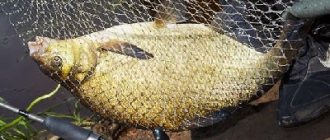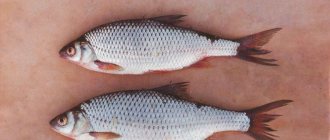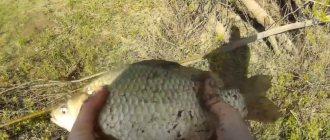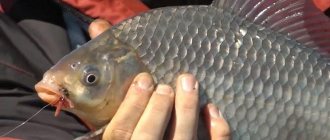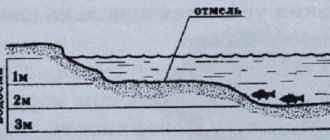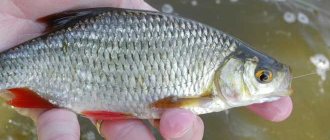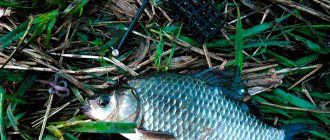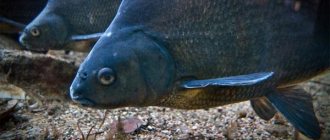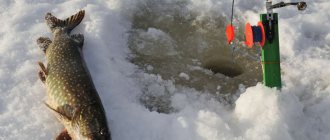Crucian carp is an omnivorous, unpretentious and the most common fish in the central zone of the Russian Federation and the CIS countries. It feeds from the bottom, chooses mostly calm water, and is found both in small ponds and in large reservoirs. Can grow up to 5 kg. It is for large specimens that the feeder equipment for catching crucian carp is intended.
Feeder assembly
In order for feeder fishing to be effective and not spoil your nerves, you need to choose the right fishing rod and assemble the gear, this is especially true for beginners who want to catch crucian carp using a feeder rig for the first time. When fishing, feeders are used, the weight of which must match the characteristics of the fishing line, reel and fishing rod. It is the fishing rod that you need to choose first.
Rod
It is most effective to catch crucian carp using a feeder in still water, in ponds and lakes, when very long casts are not needed. That is, the fishing rod must meet the following requirements:
- Fishing rod class Medium or Light with dough in the region of 70-100 grams . Please note that the weight of the feeder with food stuffed into it should be no more than the maximum test limit, and preferably less than 25 percent.
- The rod length is usually selected within 2.7-3.3 meters , two and three section fishing rods are used. The basic package should contain several (usually up to 3) vertices.
As for the cost, beginners should take a closer look at inexpensive models. Later, when certain requirements for the fishing rod appear, then you can choose a branded fishing rod.
A bright tip for the feeder form will help you clearly respond to neat bites of crucian carp at dusk
Coil
Feeder fishing requires the presence of a reel. The most common are inertia-free meat grinders. Primary requirements:
- Friction brake . It is recommended to choose reels with a front brake.
- You don't need a lot of bearings ; 4-5 are enough. This will ensure smooth operation of the reel and long operating time.
- Spool size – 2000-3000 according to Shimano classification. When winding the cord, a steel spool is selected. A plastic spool is suitable for regular fishing line.
Line VS braid
A feeder rig for catching crucian carp can be made from either fishing line or braided cord. As a rule, the choice is determined by the casting distance.
- If you are fishing for crucian carp at a short distance and on a stagnant body of water (casting up to 70 meters), it is more convenient to fish with a fishing line with a cross-section of 0.2-0.28 mm.
- If you catch crucian carp at a long distance and/or in the current (casting more than 70 meters), then braid is used. Usually, when fishing for crucian carp, a cord diameter of 0.12-0.14 mm is sufficient.
If you need to install a heavy feeder, then in this case a shock leader is knitted. This is a piece of thick fishing line, its length is two lengths of the fishing rod. It is knitted in the main line, and at the end there is a feeder and directly prepared tackle.
Feeder gum - an option that replaces the shock leader for long casts
Leashes
Installing feeder gear for crucian carp involves the presence of a leash, which consists of a piece of monofilament fishing line measuring 20-100 cm and a hook.
Attention: The breaking force of the leash should be less, unlike the main monofilament line. In this case, during a break, it will be possible to save the tackle with the feeder, and the fisherman will only need to tie a spare leash.
As a rule, in the process of knitting leashes, a fishing line with a cross section of 0.12-0.16 mm is selected. If the reservoir is clean, experts advise using fluorocarbon.
The hook is selected according to the size of the possible prey, as well as taking into account the bait used. If hooks No. 6-8 are suitable for fishing with corn and worms, then for maggots you should choose thin hooks No. 12-18.
The hook for the feeder needs to be sharp and thin
The fisherman must have leashes of various lengths in his inventory. If the fish is actively feeding, immediately swallowing the bait, it is best to use small leashes (20-50 cm). If there are a lot of empty bites, it is recommended to use long leashes (60-100 cm).
Feeder
The fisherman must have a large assortment of feeders, which differ in weight, shape, volume and material of manufacture:
- For starter feeding, it is recommended to equip the fishing rod with a large feeder. In some cases, fishermen use a stronger rod for casting bait weighing more than 120 grams.
- When fishing, the slaughtered food must be accurately dosed . Small feeders make it possible to keep crucian carp in one place without oversaturating them.
- Catching crucian carp on a feeder with a feeder on a muddy bottom forces the fisherman to replace metal products to light plastic. When they fall into the silt, they do not go deeper into it, forming a bait spot.
Different feeders for catching crucian carp and other carp
Groundbait for the feeder Flat method
In previous articles, we have repeatedly talked about bait, methods of preparing it, as well as the features of feeding bait in different fishing conditions. As for the feeder method, we can only mention a few more practical features that, for obvious reasons, were not discussed in the series of articles on the classic feeder.
First of all, unlike bait for a classic feeder, we do not need to mix a lot of method bait - as a rule, you will need from 500 g to 1 kg for the entire fishing trip.
The next feature of method feeder bait is its stickiness. If we are accustomed to fairly crumbly bait in a classic feeder, then here things are different. Specifically: the feeder for the Flat feeder method is an open type, and the bait must stay in it and retain its main volume (preferably its shape too) not only after hitting the water, but also until it is completely immersed in the bottom of the reservoir. Therefore, in order to impart excellent “sticky” properties, which will not spoil the performance characteristics of the bait, fishmeal began to be added to the bait mixtures of this category.
The next nuance: in commercial reservoirs, fish are constantly fed, as a rule, with various feeds based on the same fish meal. Thus, as you probably already guessed, the bait method will be the most attractive.
But one more nuance should also be taken into account. When I talked about classic feeder bait, I mentioned the practice of many famous sports fishermen to generously add aromatic substances to the mixture, selected for specific fishing conditions. But he also noted that large fish - carp and cupid, for example - do not really like such an abundance of aromatics in bait. And such fish will behave more cautiously and may not take the bait for a long time.
As for the presentation of method bait, there are a lot of nuances here. First of all, the feeder method is spot fishing “for candy.” If we look at a filled feeder with bait, we will see something like that “cake with a cherry on top” (photo 8). And if the “cake” (our bait) turns out to be tastier than the “cherry” (bait), it will be much more difficult to catch fish. It is important for us that the smell of “cake” does not overwhelm the smell of “cherry”.
Thus, an important feature of fishing using the feeder method is the emphasis of the bait against the background of the bait mixture.
In addition to the bait mixture, the so-called pellets (or granulated food) of small size (2 - 3 mm) can be placed in the method feeder. A feature of the pellets intended for the method feeder (photo 9) is its ability to swell and fall out of the feeder on its own. It is also called pellet expander.
Pellets are used both with regular Method flat feeders (see photo 2) and with special semi-closed scoop-type feeders (see photo 8). The latter allow you to deliver method bait and pellets to medium depths and deeper (we talked about the types of feeders in more detail in the previous article). In addition, such a feeder allows us not to focus on the special stickiness of the pellets - unlike the open Method flat feeder.
Of course, pellets are pressed into the feeder only after certain preparation. It is pre-soaked, after which it becomes suitable (obtains a certain stickiness) for pressing. After falling to the bottom of the reservoir, the pellets continue to absorb moisture, swelling and being pushed out of the feeder. The hook in this case will be hidden closer to the open part of the scoop.
Depending on the fat content of the pellets (usually indicated on the packaging by the manufacturer), the time for its preliminary preparation may vary. For example, light pellets 2 mm in diameter and 7 - 9% fat content are soaked for 1 - 1.5 minutes, after which they sit for 10 - 15 minutes to swell. But black halibut pellets (Black Halibut Pellets), even if the same in diameter, but with a fat content of 15 - 17%, should stand for 2 - 2.5 minutes soaked and 20 - 25 minutes during the swelling process, after which it may need additional moisturizing (for example, with a spray bottle or even just wet fingers).
Soaking pellets is very easy. To do this, the best and most convenient way is to use a specialized colander for pellets (photo 10). Some fishing tackle manufacturers make special inserts for plastic containers for baits and groundbaits in the form of a colander with a frame at the bottom.
They are great for soaking the pellets and removing excess moisture afterwards. You can, of course, do without it by draining the water directly through the mesh lid of a plastic container for bait and bait (which takes longer and is not as effective), or use, say, a kitchen colander. And, nevertheless, we will consider the method of soaking pellets using a special colander.
So, for daytime fishing for carp, it is enough to take 500 - 600 g of pellets (one type is possible, but sometimes a combination of two is better - for example, 50/50). If you take several types of pellets, be sure to soak them separately, because... Due to their fat content and/or diameter, their soaking time may vary.
We pour one type of pellet (for example, halibut) into a colander (photo 11). We pour water from the reservoir into a plastic container, turn on the stopwatch (everyone has one on their mobile phone) and place a colander with pellets in the container. You can pour more water (photo 12), we will still salt the excess later. Be sure to submerge the floating granules; they should settle to the bottom of the colander.
Since the pellets I chose had a diameter of 3 mm and a fat content of 17%, I set it to soak for 2.5 minutes. I try not to let the pellets drink water for longer, because... Its main task in the future, having collected additional liquid at the bottom of the reservoir, pushes itself out of the feeder. If there is nowhere for it to absorb moisture, it can simply remain in the feeder without releasing the nozzle. And we, accordingly, will not get a bite.
After the soaking time has expired, remove the colander from the container (photo 13), pour out the water from the latter and return the colander back to the now empty container. Excess moisture will drain through a colander on its own; the pellets need to stand for another 20-25 minutes (in the warm season, and usually twice as long in the cold season) to swell. The time was determined specifically for such pellets.
And, say, a light pellet with a fat content of up to 9% would be enough for 15 minutes. After all this, the pellets become quite sticky and even with light pressure takes on the shape we specified (photo 14). But as soon as you rub it with your fingers, the granules immediately separate from each other (photo 15). Next, we fill our Flat Method feeder - and we can proceed directly to fishing.
Picker rod as an option for feeder equipment
The equipment and installation of a picker when fishing for crucian carp does not differ much from the feeder. In this case, the length of the handle is shorter, since long casts are not implied, and when fishing at short distances, it only gets in the way. The length of the fishing rod is 2.1-2.7 meters, and the maximum test is up to 50 grams. Typically, spinning reels with a spool size of 1500-2000 are selected for picker.
The total weight of picker equipment is most often no more than 50 grams. You can also use heavy feeders, but the accuracy suffers greatly, and the fishing rod itself may not be able to withstand it and break.
The feeder is selected for a specific body of water. Catching crucian carp with a feeder in still water involves using cylindrical-shaped feeders, but for flows it is advisable to install rectangular models. If the depth is shallow and the bottom is muddy, then it is best to choose a light feeder up to 15 grams without additional lead plates.
Installing a feeder for catching crucian carp in the current involves the use of a square reel, and on stagnant bodies of water you can use round light feeders
Fishing is most often done at short distances, and does not often exceed 25 meters. Basically, the bait is thrown under the wall of coastal algae, in which crucian carp like to feed and hide from pike.
Method fishing gear
The weight of method feeders ranges from 10 to 80 g, the weight of the entire equipment can be up to 120 g.
Rod
The choice of rod parameters depends primarily on the weight of the equipment.
Since the method is not used to catch small crucian carp, we can recommend a carp rod with a slow or medium action. Test 80-120. Rod length 3.5-4 m.
Coil
We recommend spinning carp reels with a large, strong handle and a low gear ratio, because... These are power coils.
Reels with a fast drag are desirable, but they appeared not so long ago, so they are not available in all stores.
The number of bearings is more than three.
Considering the rod test 80-120 and the line diameter 0.32-0.4 mm, a 4500-6000 reel is suitable.
It is up to the angler to decide whether to use a reel with a baitrunner, but it should be borne in mind that using such a reel requires a lot of experience.
Manufacturers of quality reels : Shimano, Daiwa, FOX, AVID CARP, Korum. High-quality budget options: “Flagman”; "RYOBI".
Line and leash
The main line is monofilament with a cross-section of 0.32-0.4 mm.
When using a thin fishing line 0.22-0.25 mm, it is advisable to use a shock leader (a piece of braided cord with a cross-section of 0.16-0.25 mm, a length equal to the length of two rods).
The leash (5-12 cm) should be made of a soft, durable material (braid, leash cord), but sometimes you cannot do without the use of fluorocarbon leash material. This is true during the period of clear water in late autumn, also when the fish becomes capricious and picky (sharp weather changes).
Hooks
For hair equipment, carp hooks from well-known manufacturers are used, guaranteeing sharp sharpening and strength with numbers 4-12 according to the European classification.
Installation of feeder gear with a feeder for crucian carp - options with photos
If you plan to assemble and install feeder equipment yourself, then you need to master several options for different installations.
After some practice, their assembly will take no more than 2-3 minutes. The choice of installation will depend on the characteristics of the reservoir:
- For muddy bottoms, it is recommended to use a Gardner rig . This is the loop on the main line that the feeder is attached to.
- Symmetrical loop best shows the bite in a stagnant body of water, and asymmetrical, as a rule, is used on the current.
Feeder installations - Not all beginners know how to knit correctly, so they successfully use anti-twist tube, which is sold in markets and is characterized by ease of use. The main line passes through the curved tube, and the feeder is attached to a swivel located on the outer part.
Installation for fishing with anti-twist
How to make feeder equipment for crucian carp with your own hands - expert video:
Fishing place
Installing feeder gear with a feeder makes it possible to catch crucian carp in almost every pond. There is only one condition when choosing a place - it is a clean area that allows you to fish without flails, but at the same time there must be a fish stop here.
Crucian carp are heat-loving, so it is recommended to choose bodies of water without a current. When searching for a “fishing spot,” you need to pay attention to the boundaries of vegetation with clean water, approaches to holes, and different differences in the bottom.
A promising place for crucian carp fishing on a feeder in spring and summer is the area along the reeds
Catching crucian carp on a feeder in still water - video from expert fishermen:
Donka with a feeder
The key advantage of fishing with a feeder tackle with a large weight sinker is the ability to get a reliable catch. Donka is best used if the bottom is covered with a thick layer of silt.
here is to put on a sufficiently long leash , which will protrude significantly beyond the silt, allowing large crucian carp to go slightly deeper into the silt and immediately swallow the bait in the water column.
In this case, you need to make such bait so that it is gradually washed out with water, without falling in large pieces to the bottom of the reservoir.
Fishing according to the season
The feeder on the lake for crucian carp works effectively at any time of the year, taking into account open water. Only the parking areas differ.
Spring
Fishing for crucian carp in the spring in May on a feeder is the most effective, since the reservoir is already sufficiently warmed up. In this case, the fish are most often found in shallow water. As a rule, spring fishing for crucian carp with a feeder takes place near the shore at a depth of up to 2 meters. Worms, bloodworms, and maggots work best as bait.
Attention: Fishing for crucian carp in the spring occurs with the help of small feeders, so as not to quickly saturate the fish. To make them heavier, you can strengthen the equipment with a weight.
Where to look for crucian carp on the lake for successful feeder fishing in the spring
Summer fishing
When the reservoir is completely warmed up, the fish prefers to feed at depth. In the summer, fishermen use large, heavy feeders that allow them to be cast far.
Catching crucian carp on a pond in the summer is done most effectively with a worm and maggot; sometimes it makes sense to add corn or pearl barley to this tandem.
Where to look for crucian carp in summer
Fishing in autumn
Fishing in autumn is divided into several stages. In September, the fish are still quite active and gaining fat for the winter. At this time, baits of animal and plant origin are used.
The onset of frost has a negative impact on bites. The crucian carp goes to the maximum depth; for bait you will need a small amount of a low-calorie mixture. Select a small but heavy feeder. A worm or bloodworm is used as bait.
Fishing for crucian carp with feeder tackle - secrets and tactics of fishing, video from an expert:
Recipe for homemade flat bait from peas
After preparing the bait in these proportions, we will get approximately 1.5 kg of ready-made mixture for fishing on a flat feeder. There is no need to dilute it with water. This amount is quite enough for fishing during the day with one feeder.
Flat bait can be made stickier for the river and more crumbly for the lake. This property is regulated by the amount of semolina in it. More on this below.
For bait you need the following basic components:
- Peas 0.5 kg. Store-bought shelled peas will do. It is better to buy yellow peas, not orange. It is younger and its aroma is stronger. Peas are one of the best baits for carp, carp and crucian carp. In this flat bait it forms the basis. Contains protein and microelements, which give high nutritional value to the bait.
- 50 g fish meal. An important element of bait. It is better to buy it not at the market, but at a veterinary pharmacy. For bait you need very little and it is better if it is of good quality. Fishmeal contains a high concentration of amino acids and acts as a powerful attractant for carp.
- 50 g corn grits. Serves as a source of carbohydrates. It has a binding and at the same time loosening effect for bait. Corn grits give flat bread a pleasant taste and aroma.
- 20 g semolina. Serves for gluing bait. Its quantity can influence the stickiness of the mixture.
The content of semolina in the bait can regulate its stickiness. For a weak current or its absence, 20 g of semolina is enough for 0.5 kg of peas. For a fast flow of semolina you need already 50 g.
Components for flavor enhancer for flat feeder bait:
- 30 g salt (2 tablespoons) – adds saltiness.
- 30 g sugar (2 tablespoons) – adds sweetness.
- 5 g of citric acid (1 level teaspoon) – adds acidity.
- 10 g ground red hot pepper – adds spiciness.
- Vanillin 1 sachet 2 g – gives a spicy and bitter taste.
- Red food coloring 7 g. Serves to enhance the attractiveness of bait. Carp perceive orange-red color shades better. This is why many carp baits and baits are colored red.
Lure
The effectiveness of feeder fishing depends significantly on the bait used, which is bought in a store or made with your own hands. Professionals identify the following as the main criteria for high-quality feed composition:
- adhesives – no more than 7%;
- all components must be crushed;
- the fertilizing needs to be properly moistened.
Beginners are advised to purchase ready-made bait. It needs to be moistened on the shore before casting fishing rods. First add some pond water. After mixing, the composition needs to sit for about half an hour. Next, test balls are molded, which will disintegrate when they sink to the bottom. You can experiment near the shore.
Baiting crucian carp in reservoirs without current
Fishing for crucian carp on a feeder in June:
Groundbait for flat fishing
The bait for the flat method should be more viscous than that used for closed feeders. The viscosity of flat bait should be such that it does not fall out of the feeder while sinking to the bottom, but does not lie in a lump, but slowly erodes over 5 to 15 minutes.
It should have a distinct aroma, standing out in color against the background of the main food. It should be more attractive to fish than the starting bait used to create a feeding table, but not interrupt the attractiveness of the bait.
The bait can be ready-made or made independently. Sometimes both are mixed. Starter bait is cheap, but still, it is better to make it yourself.
The feeding mixture consists of ground crackers, wheat bran and cereals mixed with attractive ingredients. Its composition should also include elements of large fractions - rolled oats, corn, pellets, boilies.
Bait for fishing on a flat feeder is used sparingly; one pack should be enough for fishing. Among ready-made feeder baits for flat baits, you can pay attention to brands such as Sensas, Dynamite Baits or Browning.
DIY bait for the flat method
Homemade bait for the flat method consists of cereals, ground wheat crackers, binding components and flavorings. For bait on a flat feeder, you can use the recipe for any feeder mixture with the addition of binding components to its composition.
DIY dough boilies
This recipe for an airy bait test is suitable for making floating baits for flat feeders (cook, ottoman, boilies) for carp and crucian carp.
Composition of boilie dough:
- corn or wheat flour - 4 tablespoons;
- potato starch - 2 tablespoons;
- chicken egg - 1 pc;
- flavorings.
Dough boilies are prepared in the microwave and stored in a bag with flavoring.
Baits used
You should always have worms with you as bait. In addition to an attractive aroma for crucian carp, they are characterized by increased activity on the hook. In spring and autumn, fish are often interested in bloodworms. Maggot operates from March to September.
As a vegetable bait, fish bite well on boiled pearl barley flavored with anise or honey. Corn and dough work great.
Recommendation: If the crucian carp does not want to peck at the baits offered by the fisherman, it makes sense to try a sandwich. The most popular combinations include maggot + worm, maggot + bloodworm, dough + corn.
Sandwich made from maggots and worms
Feeder tackle gives fishing enthusiasts the opportunity to be creative. There is no need to be afraid to experiment with equipment or come up with your own bait. Only savvy fishermen will be able to fill the fish tank with large specimens.
